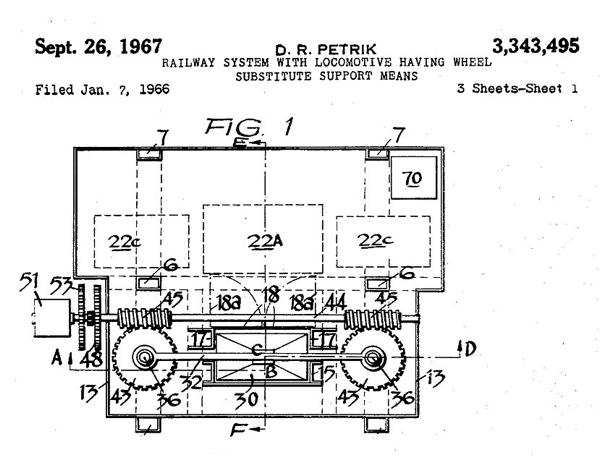Dragan Petrik’s Ice Railroad
In 1967, Dragan Petrik was granted a patent (No. 3,343,495) for a high-speed, rocket-powered train that would run on blocks of ice. In an Oct 1967 column, NY Times reporter Stacy V. Jones provided some details:
I have no idea if this would work, but it would be interesting to see it tested out.

From South Africa comes a proposal for railroad trains to run at high speed on blocks of ice instead of wheels.
Dragan R. Petrik of Pretoria was granted a patent last week for vehicles equipped to change the blocks as they melt and wear down, without stopping the train.
Patent 3,343,495 provides for propulsion by jet, rocket thrust, propellers or other means independent of the usual wheel traction. While conventional rails could be used, Petrik prefers a flanged metal surface that can be heated in cold climates.
Each car is to have cold rooms for storage of the ice. Blocks are to be forced down through ducts under control of a sensing unit that maintains the car at proper height.
Conventional wheels may be used in a station or for emergency support. A set of ice blocks is provided just ahead of and in back of each set of wheels. One ice skid can be used while another is being replenished.
For braking, there is a rubbing surface along the track, on which friction pads can be applied.
Petrik says his system will make possible very high speed for all types of land vehicles.
Dragan R. Petrik of Pretoria was granted a patent last week for vehicles equipped to change the blocks as they melt and wear down, without stopping the train.
Patent 3,343,495 provides for propulsion by jet, rocket thrust, propellers or other means independent of the usual wheel traction. While conventional rails could be used, Petrik prefers a flanged metal surface that can be heated in cold climates.
Each car is to have cold rooms for storage of the ice. Blocks are to be forced down through ducts under control of a sensing unit that maintains the car at proper height.
Conventional wheels may be used in a station or for emergency support. A set of ice blocks is provided just ahead of and in back of each set of wheels. One ice skid can be used while another is being replenished.
For braking, there is a rubbing surface along the track, on which friction pads can be applied.
Petrik says his system will make possible very high speed for all types of land vehicles.
I have no idea if this would work, but it would be interesting to see it tested out.

Comments
Anything can 'work' -- you just have to adjust your level of expectations.
I think the basic idea here is turning ice skates upside down -- instead of moving blade on ice, this is moving ice on a blade. Skates work because the pressure turns ice to water, so you're moving on a frictionless ribbon.
It'd be a weird balancing act -- not enough weight on a block of ice, it doesn't move freely because you don't have a complete plane of water; too much weight, the block fractures due to the stresses.
Best bet might be enclosing the ice in a tube, effectively making a large push-up pop. Exposing only a mm of ice would prevent block failure while maintaining a usable layer of water. Mechanism would be much more complex than shown in this patent.
It might be more efficient and economical to simply pump water into downward-facing nozzles. Easier to control, no complex handling, and you could recover your working fluid with a squeegee and vacuum at the back.
I think the basic idea here is turning ice skates upside down -- instead of moving blade on ice, this is moving ice on a blade. Skates work because the pressure turns ice to water, so you're moving on a frictionless ribbon.
It'd be a weird balancing act -- not enough weight on a block of ice, it doesn't move freely because you don't have a complete plane of water; too much weight, the block fractures due to the stresses.
Best bet might be enclosing the ice in a tube, effectively making a large push-up pop. Exposing only a mm of ice would prevent block failure while maintaining a usable layer of water. Mechanism would be much more complex than shown in this patent.
It might be more efficient and economical to simply pump water into downward-facing nozzles. Easier to control, no complex handling, and you could recover your working fluid with a squeegee and vacuum at the back.
Posted by Phideaux on 04/17/22 at 02:16 PM
Sounds like a thermodynamic loser, at best. I'd agree with water jets being better.
We need neither. Of course, we now have magnets they were only dreaming about in 1967.
We need neither. Of course, we now have magnets they were only dreaming about in 1967.
Posted by Virtual in Carnate on 04/17/22 at 05:48 PM
Commenting is not available in this channel entry.



Category: Patents | Trains and Other Vehicles on Rails | 1960s